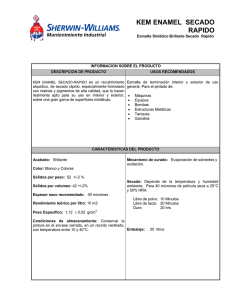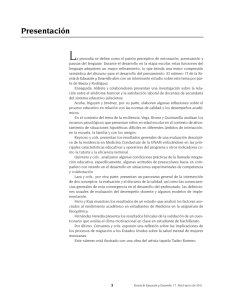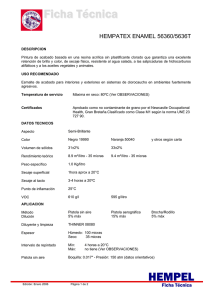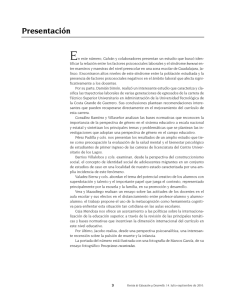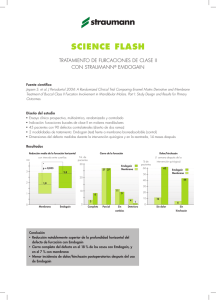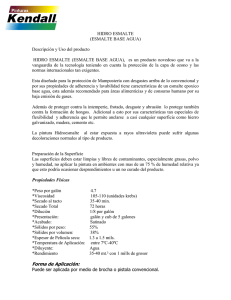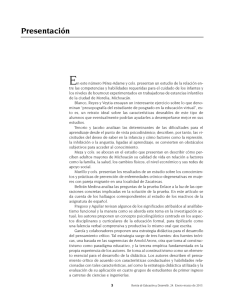Alteraciones de la estructura en la dentición temporal y en la
Anuncio
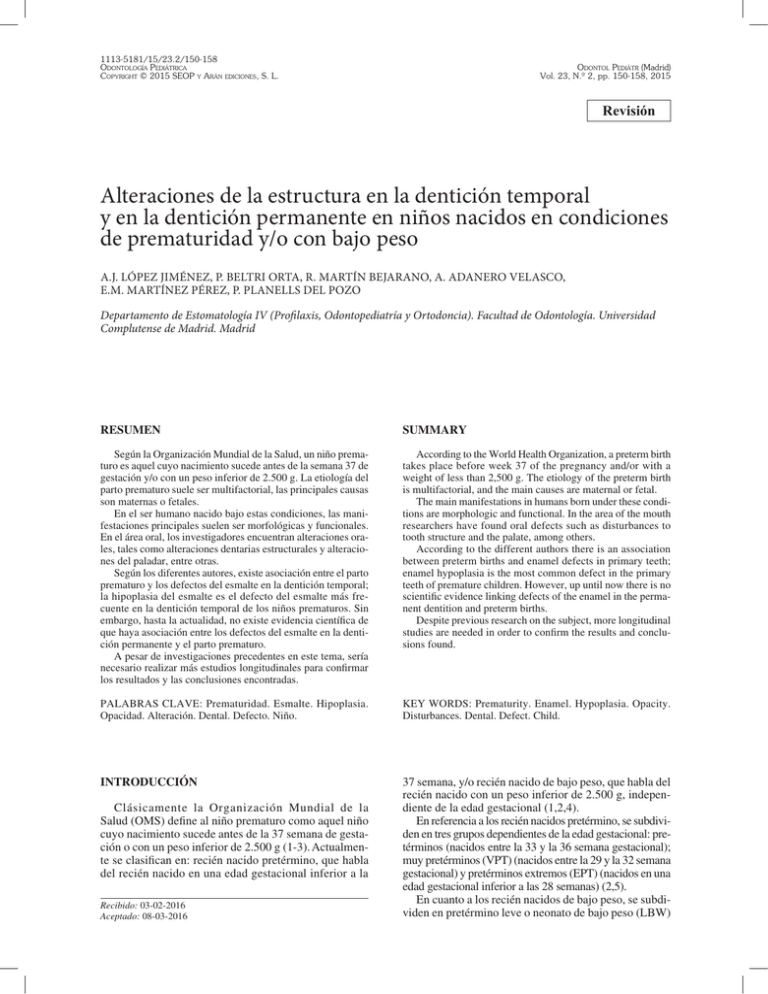
1113-5181/15/23.2/150-158 Odontología Pediátrica Copyright © 2015 SEOP y Arán ediciones, S. L. Odontol Pediátr (Madrid) Vol. 23, N.º 2, pp. 150-158, 2015 Revisión Alteraciones de la estructura en la dentición temporal y en la dentición permanente en niños nacidos en condiciones de prematuridad y/o con bajo peso A.J. LÓPEZ JIMÉNEZ, P. BELTRI ORTA, R. MARTÍN BEJARANO, A. ADANERO VELASCO, E.M. MARTÍNEZ PÉREZ, P. PLANELLS DEL POZO Departamento de Estomatología IV (Profilaxis, Odontopediatría y Ortodoncia). Facultad de Odontología. Universidad Complutense de Madrid. Madrid RESUMEN SUMMARY Según la Organización Mundial de la Salud, un niño prematuro es aquel cuyo nacimiento sucede antes de la semana 37 de gestación y/o con un peso inferior de 2.500 g. La etiología del parto prematuro suele ser multifactorial, las principales causas son maternas o fetales. En el ser humano nacido bajo estas condiciones, las manifestaciones principales suelen ser morfológicas y funcionales. En el área oral, los investigadores encuentran alteraciones orales, tales como alteraciones dentarias estructurales y alteraciones del paladar, entre otras. Según los diferentes autores, existe asociación entre el parto prematuro y los defectos del esmalte en la dentición temporal; la hipoplasia del esmalte es el defecto del esmalte más frecuente en la dentición temporal de los niños prematuros. Sin embargo, hasta la actualidad, no existe evidencia científica de que haya asociación entre los defectos del esmalte en la dentición permanente y el parto prematuro. A pesar de investigaciones precedentes en este tema, sería necesario realizar más estudios longitudinales para confirmar los resultados y las conclusiones encontradas. According to the World Health Organization, a preterm birth takes place before week 37 of the pregnancy and/or with a weight of less than 2,500 g. The etiology of the preterm birth is multifactorial, and the main causes are maternal or fetal. The main manifestations in humans born under these conditions are morphologic and functional. In the area of the mouth researchers have found oral defects such as disturbances to tooth structure and the palate, among others. According to the different authors there is an association between preterm births and enamel defects in primary teeth; enamel hypoplasia is the most common defect in the primary teeth of premature children. However, up until now there is no scientific evidence linking defects of the enamel in the permanent dentition and preterm births. Despite previous research on the subject, more longitudinal studies are needed in order to confirm the results and conclusions found. PALABRAS CLAVE: Prematuridad. Esmalte. Hipoplasia. Opacidad. Alteración. Dental. Defecto. Niño. KEY WORDS: Prematurity. Enamel. Hypoplasia. Opacity. Disturbances. Dental. Defect. Child. INTRODUCCIÓN 37 semana, y/o recién nacido de bajo peso, que habla del recién nacido con un peso inferior de 2.500 g, independiente de la edad gestacional (1,2,4). En referencia a los recién nacidos pretérmino, se subdividen en tres grupos dependientes de la edad gestacional: pretérminos (nacidos entre la 33 y la 36 semana gestacional); muy pretérminos (VPT) (nacidos entre la 29 y la 32 semana gestacional) y pretérminos extremos (EPT) (nacidos en una edad gestacional inferior a las 28 semanas) (2,5). En cuanto a los recién nacidos de bajo peso, se subdividen en pretérmino leve o neonato de bajo peso (LBW) Clásicamente la Organización Mundial de la Salud (OMS) define al niño prematuro como aquel niño cuyo nacimiento sucede antes de la 37 semana de gestación o con un peso inferior de 2.500 g (1-3). Actualmente se clasifican en: recién nacido pretérmino, que habla del recién nacido en una edad gestacional inferior a la Recibido: 03-02-2016 Aceptado: 08-03-2016 Vol. 23, N.º 2, 2015 ALTERACIONES DE LA ESTRUCTURA EN LA DENTICIÓN TEMPORAL Y EN LA DENTICIÓN PERMANENTE EN NIÑOS NACIDOS EN CONDICIONES DE PREMATURIDAD Y/O CON BAJO PESO (niño con un peso entre 1.500 y 2.500 g); grandes pretérminos o neonatos de muy bajo peso (VLBW) (niño con un peso inferior de 1.500 g) y muy grandes pretérminos o neonatos de peso extremadamente bajo (ELBW) (niños de un peso inferior en 1.000 g) (2,5). El nacimiento prematuro es la principal causa de mortalidad entre los recién nacidos vivos durante las primeras cuatro semanas de vida y la segunda causa de muerte entre los niños menores de cinco años, después de la neumonía (3). La etiología del nacimiento prematuro es desconocida, pero puede deberse a causas maternas o fetales, que generalmente son de carácter multifactorial. En ocasiones, estos niños presentan unas características específicas que pueden ser morfológicas y/o funcionales, que pueden llegar a generar secuelas graves en el adulto (6,7). En el órgano dentario destacan las secuelas encontradas a nivel estructural en el esmalte (8). Los dientes primarios comienzan su desarrollo durante el embarazo y se completan en la primera infancia (9). La mineralización de los dientes primarios se inicia durante el cuarto mes de embarazo, y la finalización de la mineralización de la corona del primer diente se ha producido con un año de edad. Observan unas marcas dentales de calcificación o líneas incrementales que marcan el momento del nacimiento, se producen tanto en el esmalte (banda de Retzius) como en la dentina (línea de Owen) (6,10). Si hay una complicación en el momento del parto, se produce una acentuación de estas marcas (4). En los niños nacidos en condiciones de prematuridad, según Rythen y cols., la fase de mineralización se reduce en 10 semanas o más. Los niños pretérminos extremos pierden el periodo más importante de desarrollo que se produce durante el tercer trimestre del embarazo en que se incorporan algunos elementos como carbono, oxígeno, fósforo y calcio (10,11). Los defectos del esmalte en estos niños se sitúan en el tercio medio de las coronas de los incisivos y en el tercio cervical de los caninos (10,12) (Tabla I). 151 Hay varios factores que interfieren con la formación de los dientes. Los factores prenatales asociados con alteraciones de mineralización son, entre otros, las infecciones maternas, enfermedades metabólicas, trastornos nutricionales y la ingesta materna de sustancias como la tetraciclina. Los factores posnatales asociados con alteraciones de mineralización son, entre otros, complicaciones en el parto, infecciones posnatales y enfermedades sistémicas (9). Estos defectos del esmalte se clasifican en hipoplasia del esmalte e hipomineralización u opacidad del esmalte (13-15). La hipomineralización del esmalte se debe a un defecto cualitativo que se identifica visualmente como un cambio de translucidez del esmalte; se puede observar un esmalte de diferentes colores como blanquecino, marrón o amarillento y la lesión varía en extensión y localización. Puede deberse a causas: locales, como un traumatismo local o infecciones periapicales; sistémicas, como raquitismo, ingesta excesiva de flúor, o hereditarias (14,15). Mientras que la hipoplasia es un defecto cuantitativo y se observa una disminución en el espesor del esmalte, son múltiples los factores que pueden originar la hipoplasia; estos pueden ser locales, al afectar a uno o dos dientes, y son factores de riesgo las infecciones locales o los traumatismos locales; o sistémicos, cuyos factores de riesgo son hipocalcemia, enfermedades sistémicas, déficit nutricional o fluorosis; y hereditarias (13,16-18). OBJETIVO Nos proponemos actualizar los conceptos referentes a las posibles secuelas presentes en el órgano dentario tanto en la dentición temporal como en la dentición permanente en los niños nacidos en condiciones de prematuridad y/o bajo peso. TABLA I EDADES DE FORMACIÓN DE LOS DIENTES TEMPORALES SEGÚN LOGAN Y KRONFELD Superior Dientes primarios Comienzo de la formación de los tejidos duros Cantidad de esmalte formado al nacer Edad de finalización de formación del esmalte Edad de erupción Edad de finalización de formación de la raíz Incisivo central 4 meses vida intrauterina (m. v. i) 5/6 1 ½ meses (m) 7½m 1 ½ año (a) Incisivo lateral 4 ½ m. v. i 2/3 2½m 9m 2a Canino 5 m. v. i 1/3 9m 18 m 3¼a 1. molar 5 m. v. i Cúspides 6m 14 m 2½a er Inferior 2.° molar 6 m. v. i Vértices cuspídeas 11 m 24 m 3a Incisivo central 4 ½ m. v. i 3/5 2½m 6m 1½a Incisivo lateral 4 ½ m. v. i 3/5 3m 7m 1½a Canino 5 m. v. i 1/3 9m 16 m 3½a 1. molar 5 m. v. i Cúspides 5½m 12 m 2¼a 2.° molar 6 m. v. i Vértices cuspídeas 10 m 20 m 3a er Odontol Pediatr 2015; 23 (2): 150-158 152 A. J. LÓPEZ JIMÉNEZ ET AL. MATERIAL Y MÉTODOS La búsqueda bibliográfica se realizó en la base de datos Scopus de la biblioteca de la Facultad de Odontología de la Universidad Complutense de Madrid y en la base de datos de PubMed. Las palabras claves utilizadas son: Prematurity, Dental care, Child*, Growth, Enamel y Disturbances. La búsqueda se limita a artículos en inglés y en español, durante el periodo de 1990 a 2014; el primer estudio es el de Fearne y cols. en 1990 (19) y el último de Jacobsen y cols. en 2014 (12). Además, nos limitamos a la búsqueda de artículos de revisión, de casos y controles y de estudios longitudinales. RESULTADOS Y DISCUSIÓN El total de artículos encontrados fue de 65, de los cuales fueron excluidos 45 por no cumplir los criterios de inclusión. Odontol Pediátr Englobamos cualquier estudio de cualquier parte del mundo, ocho son de Europa (9,10,12,19-23), uno de EE. UU. (24), cinco de Sudamérica (8,13,25-27), cuatro de Australia (2,3,15,28) y dos de Asia (29,30). En cuanto a la dentición, diez estudiaron exclusivamente la dentición temporal (9,10,13,19,21,23,26,27,29,30); tres estudiaron la dentición permanente (2,22,24) y siete estudiaron ambas denticiones (2,8,12,15,20,23,28). Tras analizar los artículos (Tabla II), obtenemos: DENTICIÓN TEMPORAL En la dentición temporal, Gravina y cols. (7), CorrêaFaria y cols. (25) y Takaoka y cols. (13) observaron que es estadísticamente significativa la asociación entre defectos del esmalte y parto prematuro, concordando con Li y cols. (29), Seow y cols. (2,4), Fearne y cols. (19) y Aine y cols. (23), pero hay discrepancia entre TABLA II RESULTADOS DE LOS ARTÍCULOS REVISADOS EN LA REVISIÓN BIBLIOGRÁFICA Resumen de artículos revisados que estudian los tipos de defecto y la prematuridad Referencia Año País Número de pacientes y edad Dentición observada Tipos de defectos observadas Dentición temporal Opacidad Hipoplasia Defectos del esmalte sin distinción Fearne y cols. 1990 Inglaterra Casos: 60 niños VLBW y 50 LBW; 4-5 años Controles: 93; 4-5 años Lai y cols. 1997 Australia Casos: 24 niños VLBW; 4-5 años Controles: 20; 4-5 años Dentición temporal Opacidad Hipoplasia Seow 1997 Australia Niños VLBW y LBW Dentición temporal Dentición permanente Hipoplasia Opacidad Dentición temporal Dentición permanente Defectos del esmalte sin distinguir en ambas denticiones Aine y cols. 2000 Finlandia Casos: 32 niños LBW; 1-2 años y 32; 9-11 años Controles: 64; 1-2 años, 64, 9-11 años Franco y cols. 2007 Brasil Casos: 61 niños LBW; 18-34 meses Controles: 61; 31-35 meses Dentición temporal Hipoplasia Opacidad Ferrini y cols. 2008 Brasil Casos: 52 niños ELBW + VLBW; 2-4 años Controles: 52; 2-4 años Dentición temporal Defectos del esmalte sin distinción Velló y cols. 2010 España Casos: 52 niños LBW; 4-5 años Controles: 50: 4-5 años Dentición temporal Opacidad Hipoplasia Takaoka y cols. 2010 Brasil Casos: 45 niños LBW; 2-3 años Controles: 46; 2-4 años Dentición temporal Defectos del esmalte sin distinción Nelson y cols. 2010 EE. UU. Casos: 139 niños VLBW; 14 años Controles: 85; 14 años Dentición permanente Hipoplasia Opacidad Brogardh-Roth y cols. 2011 Suecia Casos: 62 VPT y 20 EPT; 9-12 años Controles: 82; 9-12 años Dentición permanente Hipoplasia Opacidad Síndrome Incisivo-Molar Dentición temporal Dentición permanente Hipoplasia Opacidad Dentición temporal Hipoplasia Opacidad Rythen y cols. 2012 Suecia Casos: 40 niños VPT; 12-16, además ser observados a los 9 años Controles: 40; 12-16, además de ser observados a los 9 años Bansal y cols. 2012 India Casos: 58 niños VLBW y 60 LBW; 9-35 meses Controles: 50; 9-35 meses (Continúa en la página siguiente) Odontol Pediatr 2015; 23 (2): 150-158 Vol. 23, N.º 2, 2015 ALTERACIONES DE LA ESTRUCTURA EN LA DENTICIÓN TEMPORAL Y EN LA DENTICIÓN PERMANENTE EN NIÑOS NACIDOS EN CONDICIONES DE PREMATURIDAD Y/O CON BAJO PESO 153 TABLA II (CONT.) RESULTADOS DE LOS ARTÍCULOS REVISADOS EN LA REVISIÓN BIBLIOGRÁFICA Resumen de artículos revisados que estudian los tipos de defecto y la prematuridad Referencia Año País Número de pacientes y edad Dentición observada Tipos de defectos observadas Gravina y cols. 2013 Brasil Casos: 96 niños VLBW; 1644 meses Controles: 96; 24-56 meses Dentición temporal Hipoplasia Opacidad Corrêa-Faria y cols. 2013 Brasil 381 niños; 3-5 años Dentición temporal Hipoplasia Opacidad VPT: muy pretérmino; EPT: pretérmino extremo; LBW: neonato de bajo peso; VLBW: neonato de muy bajo peso; ELBW: neonato de peso extremadamente bajo. los autores, como Corrêa-Faria y cols. (25), Rythen y cols. (9), Takaoka y cols. (13), Ferrini y cols. (27) y Li y cols. (29), según el tipo de defectos del esmalte, bien sea hipoplasia o bien opacidad o hipomineralización. Ciertos investigadores (4,8,19,21,23,30) coinciden en que la hipoplasia del esmalte es el defecto más frecuente entre los niños prematuros, siendo significativamente estadístico en los estudios de casos y controles al comparar el grupo de niños en condiciones de prematuridad y el grupo de control. Al hablar de opacidades o hipomineralizaciones del esmalte, hay discrepancia entre los autores, ya que unos autores (2,26) obtienen resultados estadísticamente significativos y concluyen que hay asociación entre opacidad y niños con muy bajo peso y otros (8,19) no obtienen resultados significativos para dicha asociación. Cuando observamos los defectos del esmalte, en general, Takaoka y cols. (13), Ferrini y cols. (27) y Aine y cols. (23) hablan de una relación directa entre la presencia de los defectos del esmalte y la prematuridad, coincidiendo con Fearne y cols. (19), que además indican que es en niños con muy bajo peso donde se produce la mayor prevalencia de defectos, 77 %, mientras que en el grupo control se presentan entre 3-7%. Gravina y cols. (8) y Seow y cols. (4) hablan de los posibles factores de riesgo de la prematuridad, como son la ventilación intraoral, la edad materna o la nutrición, entre otras cosas, pero debido a la falta de estudios no se puede concluir que haya una relación directa con los defectos del esmalte. Sobre el uso de la ventilación intraoral, Seow (2) observó que había defectos locales en el esmalte y observó un 63% de defectos del esmalte en aquellos niños que estuvieron intubados frente a un 40% de defectos en aquellos que no lo estuvieron, siendo más frecuente en niños de muy bajo peso. Takaoka y cols. (13) y Gravina y cols. (8) coinciden con Seow (2) al observar defectos locales del esmalte en los dientes de aquellos niños que tenían ventilación intraoral. En cuanto a los dientes afectados en la dentición temporal, Gravina y cols. (8), Corrêa-Faria y cols. (25) y Franco y cols. (26) observan mayores defectos del esmalte en los incisivos centrales superiores, coincidiendo con Li y cols. (29) y Fearne y cols. (19). DENTICIÓN PERMANENTE En cuanto a la dentición permanente, no hay un consenso entre los autores. Aine y cols. (23) y Nelson y Odontol Pediatr 2015; 23 (2): 150-158 cols. (24) observan una relación estadísticamente significativa entre los defectos del esmalte, sin diferenciar entre hipoplasia y opacidad, en la dentición permanente y en niños de muy bajo peso. Seow y cols. (2) observan mayor afectación en los incisivos superiores y en los primeros molares, siendo más frecuente las opacidades en dichos dientes, coincidiendo Nelson y cols. (24). Además, encontraron asociación en la dentición permanente y niños con muy bajo peso. En contraposición, Rythen y cols. (20) y Jacobsen y cols. (12) no encuentran asociación entre los defectos del esmalte en la dentición permanente y parto prematuro; además, en sus investigaciones no hacen distinción entre los tipos de defectos del esmalte CONCLUSIONES Según los estudios revisados, parece existir una asociación entre el parto prematuro y los defectos del esmalte en la dentición temporal. En lo que respecta al tipo de patología presente, las alteraciones en la mineralización del esmalte son el defecto más frecuentemente hallado en la dentición temporal de los recién nacidos prematuros. Hasta el momento, no existe evidencia científica de que haya asociación entre los defectos del esmalte en la dentición permanente y el parto prematuro. En cualquier caso, son necesarios estudios más amplios para reforzar las conclusiones antes descritas. CORRESPONDENCIA: Paloma Planells del Pozo Universidad Complutense de Madrid. Madrid Facultad de Odontología Departamento IV (Ortodoncia, Odontopediatría y Profilaxis) Pza. Ramón y Cajal, s/n 28040 Madrid e-mail: pplanells@telefonica.net BIBLIOGRAFÍA 1. Paulsson L, Bondemark L, Soderfeldt B. A systematic review of the consequences of premature birth on palatal morphology, dental occlusion, tooth-crown dimensions, and tooth maturity and eruption. Angle Orthod 2004;74:269-79. 2. Seow WK. Effects of preterm birth on oral growth and development. Aust Dent J 1997;42:85-91. 154 A. J. LÓPEZ JIMÉNEZ ET AL. 3. En http://www.who.int/mediacentre/factsheets/fs363/es/ 4. Seow WK, Wan A. A controlled study of the morphometric changes of the dentition in preterm children. J Dent Res 1999;79:63-9. 5. Rellán-Rodríguez S, García de Ribera C, Aragón-García MP. El recién nacido prematuro. En: Protocolos Diagnóstico Terapéuticos de la AEP: Neonatología. Asociación Española de Pediatría. Madrid; 2008. 6. Harila V, Heikkinen T, Alvesalo L. Deciduous tooth crown size in prematurely born children. Ear Hum Dev 2003;75:9-20. 7. Harila-Kaera V, Heikkinen T, Alvesalo L, Osborne RH. Permanent tooth crown dimension in prematurely born children. Earl Hum Develop 2001;62:131-47. 8. Gravina DB, Cruvinel VR, Azevedo TD, Toledo OA, Bezerra AC. Enamel defects in the primary dentition of preterm and full-term children. J Clin Pediatr Dent 2013 Summer;37(4):391-5. 9. Rythen M, Noren JG, Sabel N, Steiniger F, Niklasson A, Hellstrom A, et al. Morphological aspects of dental hard tissues in primary teeth from preterm infants. Int J Paediatr Dent 2008;18:397-406. 10. Rythen M, Sabel N, Dietz W, Robertson A, Noren JG. Chemical aspects on dental hard tissues in primary teeth from preterm infants. Eur J Oral Sci 2010;118:389-95. 11. Klingberg G, Dietz W, Oskarsdóttir S, Odelius H, Gelander L, Norén JG. Morphological appeareance and chemical composition of enamel in primary teeth from patientes with 22q11 deletion síndrome. Eur J Oral Sci 2005;113:303-11. 12. Jacobsen PE, Haubek D, Henriksen TB, Østergaard JR, Poulsen S. Developmental enamel defects in children born preterm: a systematic review. Eur J Oral Sci 2014;122:7-14. 13. Takaoka LA, Goulart AL, Kopelman BI, Weiler RM. Enamel defects in the complete primary dentition of children born at term and preterm. Pediatr Dent 2011; 33:171-6. 14. Vettore MV, Leao AT, Leal MC, Feres M, Shelman A. The relationship between periodontal disease and preterm low birthweight: clinical and microbiological results. J Periodont Res 2008;43:615-26. 15. Seow WK, Tsang AKL, Young WG, Daley T. A study of primary dental enamel from preterm and full-term children using light and scanning electron microscopy. Pediatr Dent 2005;27 (5):374-79. 16. Saavedra-Marbán G, Planells del Pozo P, Ruiz-Extremera A. Patología orofacial en niños nacidos en condiciones de alto riesgo. Estudio piloto. RCOE 2004;9(2):151-8. 17. Jalevik B, Klingberg GA. Dental treatment, dental fear and behaviour management problems in children with severe enamel 18. 19. 20. 21. 22. 23. 24. 25. 26. 27. 28. 29. 30. Odontol Pediátr hypomineralization of their permanent first molars. Int J Paediatr Dent 2002;12:24-32. Seow WK. Enamel hypoplasi in the primary dentition: a review. J Dent Child 1991;58:44-52. Fearne JM, Bryan EM, Elliman AM, Brook AH, Williams DM. Enamel defects in the primary dentition of children born weighing less than 2000 g. Br Dent J 1990;168:433-7. Rythen M, Niklasson A, Hellstrom A, Hakeberg M, Robertson A. Risk indicators for poor oral health in adolescents born extremely preterm. Swed Dent J 2012;36:115-24. Vello MA, Martínez-Costa C, Catalá M, Fons J, Brines J, Guijarro-Martínez R. Prenatal and neonatal risk factors for the development of enamel defects in low birth weight children. Oral Dis 2010; 16:257-62. Brogardh-Roth S, Matsson L, Klingberg G. Molar-incisor hypomineralization and oral hygiene in 10- to-12-yr-old Swedish children born preterm. Eur J Oral Sci 2011;119:33-9. Aine L, Backstrom MC, Maki R, Kuusela AL, Koivisto AM, Ikonen RS, et al. Enamel defects in primary and permanent teeth of children born prematurely. J Oral Pathol Med 2000;29: 403-409. Nelson S, Albert JM, Lombardi G, Wishnek S, Asaad G, Kirchner HL, et al. Dental caries and enamel defects in very low birth weight adolescents. Caries Res 2010;44:509-18. Corrêa-Faria P, Martins-Júnior PA, Vieira-Andrade RG, Oliveira-Ferreira F, Marques LS, Ramos-Jorge ML. Developmental defects of enamel in primary teeth: prevalence and associated factors. Int J Paediatr Dent 2013;23:173-9. Franco KM, Line SR, De Moura-Ribeiro MV. Prenatal and neonatal variables associated with enamel hypoplasia in deciduous teeth in low birth weight preterm infants. J Appl Oral Sci 2007;15:518-23. Ferrini FR, Marba ST, Gaviao MB. Oral conditions in very low and extremely low birth weight children. J Dent Child (Chic) 2008;75:235-42. Lai PY, Seow WK, Tudehope DI, Rogers Y. Enamel hypoplasia and dental caries in very-low birthweight children: a case-controlled, longitudinal study. Pediatr Dent 1997;19:42-9. Li Y, Navia JM, Bian JY. Prevalence and distribution of developmental enamel defects in primary dentition of Chinese children 3-5 years old. Community Dent Oral Epidemiol 1995; 23:72-9. Bansal R, Bansal R, Sharma A, Sidram G. Effect of low birth weight and very low birth weight on primary dentition in the Indian population. Internet J Pediatr Neonatol 2012;14. Review Disturbances to the structure of primary and permanent teeth in preterm and/or low weight infants A.J. LÓPEZ JIMÉNEZ, P. BELTRI ORTA, R. MARTÍN BEJARANO, A. ADANERO VELASCO, E.M. MARTÍNEZ PÉREZ, P. PLANELLS DEL POZO Department of Stomatology IV (Pediatric Dentistry Profilaxis and Orthodontic Dentistry). School of Odontology. Universidad Complutense de Madrid. Madrid, Spain Odontol Pediatr 2015; 23 (2): 150-158 Vol. 23, N.º 2, 2015 DISTURBANCES TO THE STRUCTURE OF PRIMARY AND PERMANENT TEETH IN PRETERM AND/OR LOW WEIGHT INFANTS 155 SUMMARY RESUMEN According to the World Health Organization, a preterm birth takes place before week 37 of the pregnancy and/or with a weight of less than 2,500 g. The etiology of the preterm birth is multifactorial, and the main causes are maternal or fetal. The main manifestations in humans born under these conditions are morphologic and functional. In the area of the mouth researchers have found oral defects such as disturbances to tooth structure and the palate, among others. According to the different authors there is an association between preterm births and enamel defects in primary teeth; enamel hypoplasia is the most common defect in the primary teeth of premature children. However, up until now there is no scientific evidence linking defects of the enamel in the permanent dentition and preterm births. Despite previous research on the subject, more longitudinal studies are needed in order to confirm the results and conclusions found. Según la Organización Mundial de la Salud, un niño prematuro es aquel cuyo nacimiento sucede antes de la semana 37 de gestación y/o con un peso inferior de 2.500 g. La etiología del parto prematuro suele ser multifactorial, las principales causas son maternas o fetales. En el ser humano nacido bajo estas condiciones, las manifestaciones principales suelen ser morfológicas y funcionales. En el área oral, los investigadores encuentran alteraciones orales, tales como alteraciones dentarias estructurales y alteraciones del paladar, entre otras. Según los diferentes autores, existe asociación entre el parto prematuro y los defectos del esmalte en la dentición temporal; la hipoplasia del esmalte es el defecto del esmalte más frecuente en la dentición temporal de los niños prematuros. Sin embargo, hasta la actualidad, no existe evidencia científica de que haya asociación entre los defectos del esmalte en la dentición permanente y el parto prematuro. A pesar de investigaciones precedentes en este tema, sería necesario realizar más estudios longitudinales para confirmar los resultados y las conclusiones encontradas. KEY WORDS: Prematurity. Enamel. Hypoplasia. Opacity. Disturbances. Dental. Defect. Child. PALABRAS CLAVE: Prematuridad. Esmalte. Hipoplasia. Opacidad. Alteración. Dental. Defecto. Niño. INTRODUCTION first tooth takes place at the age of one year. Dental calcification marks or incremental lines will be noticed and these indicate the moment of birth, and they arise in both enamel (Line of Retzius) and dentin (Owens line) (6,10). If there is a complication during the delivery, these lines will be accentuated (4). According to Rythen, Klingberg and Jacobsen, in preterm births the mineralization phase is reduced to 10 weeks or more. Extremely preterm children lose out on the most important development period which takes place during the third term of the pregnancy during which some elements such as carbon, oxygen, phosphorus and calcium are lost (10,11). The defects in the enamel of these children are situated in the middle third of the incisor crown and in the cervical third of the canines (10, 12) (Table I). There are various factors that interfere with tooth formation. The prenatal factors associated with disturbances to mineralization are, among others, maternal infections, metabolic disease, nutritional disorders, and maternal ingestion of substances such as tetracycline. The post-natal factors associated with disturbances to mineralization are, among others, complications during birth, post-natal infections and systemic disease (9). These enamel defects are classified as enamel hypoplasia and hypomineralization or enamel opacities (13-15). The hypomineralization of the enamel is due to a qualitative defect that is visually identified as an alteration in the translucency of the enamel. Enamel of different colors can be observed which may be whitish, brown or yellow and the lesions vary in size and location. The reasons may be local, such as local trauma or periapical infections; they may be systemic, such as rickets or excessive ingestion of fluoride, or they may be hereditary (14,15). Classically the World Health Organization (WHO) definition for a preterm delivery is a delivery before week 37 of the pregnancy or a birth weight less than 2,500 (1-3). Currently preterm is classified as a newborn with a gestational age under 37 weeks and/or low weight, weighing less than 2,500 g, regardless of gestational age (1, 2, 4). With regard to preterm newborn infants, these are divided into three subtypes depending on gestational age: preterm (born between gestational week 33 and 36); very preterm (VPT) (born between gestational weeks 29-32), and extreme preterm (EPT) (with a gestational age of under 28 weeks) (2,5). With regard to low neonate weights, these are subdivided into low birth weight (LBW) (infant weighing between 1,500 and 2,500 g); very low birth weight (VLBW) (infant weighing under 1,500 g), extremely low birth weight (ELBW) (infant weighing under 1,000 g) (2,5). Premature birth is the main cause of mortality among live newborns during the first four weeks of life, and the second cause of death among children under five years of age after pneumonia (3). The etiology of preterm births is unknown but they may be due to maternal or fetal reasons, and they generally have a multifactorial origin. On occasions these children have specific characteristics, which may be morphological and/or functional, and that may lead to serious sequelae in adulthood (6,7). With regard to teeth, structural sequelae of the enamel are a feature (8). Primary teeth start developing during the pregnancy and finish during early childhood (9). The mineralization of primary teeth starts during the fourth month of pregnancy and the mineralization of the crown of the Odontol Pediatr 2015; 23 (2): 150-158 156 A. J. LÓPEZ JIMÉNEZ ET AL. Odontol Pediátr TABLE I PRIMARY TOOTH FORMATION AGE ACCORDING TO LOGAN AND KRONFELD Upper Primary teeth Hard tissue formation begins Amount of enamel formed at birth Age when enamel formation is completed Age on eruption Age when the root formation is completed Central incisor 4 months of intrauterine life (m. i. l) 5/6 1 ½ months (m) 7½m 1 ½ years (y) Lateral incisor 4 ½ m. i. l 2/3 2½m 9m 2y Canine 5 m. i. l 1/3 9m 18 m 3¼y 1 molar 5 m. i. l Cusps 6m 14 m 2½y 2 molar 6 m. i. l Cusp tips 11 m 24 m 3y st nd Lower Central incisor 4 ½ m. i. l 3/5 2½m 6m 1½y Lateral incisor 4 ½ m. i. l 3/5 3m 7m 1½y Canine 5 m. i. l 1/3 9m 16 m 3½y 1 molar 5 m. i. l Cusps 5½m 12 m 2¼y 2 molar 6 m. i. l Cusp tips 10 m 20 m 3y st nd However, hypoplasia is a quantitative defect and a reduction in the thickness of the enamel can be observed. There are multiple factors leading to hypoplasia which may be local, affecting one or two teeth with local infection or local trauma being risk factors. The reasons may also be systemic and the risk factors include hypercalcemia, systemic disease, nutritional deficiencies or fluorosis, and they may also be hereditary (13, 16-18). from the United States (24), five from South America (8,13,25,26,27), four from Australia (2,3,15,28) and two from Asia (29,30). With regard to the dentition, ten studied only the primary dentition (9,10,13,19,21,23,26,27,29,30); three studied the permanent dentition (2,22,24), and seven studied both dentitions (2,8,12,15,20,23,28). After an analysis of the papers (Table II), the following was obtained. OBJECTIVE PRIMARY DENTITION The purpose of this paper was to provide an update on the concepts regarding the possible sequelae for the teeth in both the primary and permanent dentition in children born preterm and/or with low weight. In the primary dentition Gravina et al. (7), Corrêa-Faria et al. (25) and Takaoka et al. (13) observed that the association between defects of the enamel and preterm birth was statistically significant, which matched the conclusions of Li et al. (29), Seow et al. (2,4), Fearne et al. (19) and Aine et al. (23), but there was a discrepancy with other authors such as Corrêa-Faria et al. (25), Rythen et al. (9), Takaoka et al. (13), Ferrini et al. (27) and Li et al. (29), regarding the type of enamel defect, either hypoplasia or opacity or hypomineralization. Certain researchers (4,8,19,21,23,30) agree that enamel hypoplasia is the most common defect among preterm children, and that this is statistically significant in case-control studies when a preterm group of children are compared with a control group. With regard to opacities or hypomineralization of the enamel there is a discrepancy between authors, as some authors (2,26) obtained statistically significant results, concluding that there is an association between opacity and infants with a very low weight while others (8,19) did not obtain significant results for this association. When enamel defects are observed in general, Takaoka et al. (13), Ferrini et al. (27) and Aine et al. (23) point to a direct relationship between the presence enamel defects and prematurity, concurring with Fearne et al. (19) who in addition pointed out that low weight infants, and those with the greatest number of defects, amounted to 77% while the control group was between 3-7%. MATERIAL AND METHODS A search of the literature was performed using the databases of Scopus in the library of the Faculty of Dentistry of the Universidad Complutense de Madrid and in the databases of PubMed. They keywords used were: Prematurity, Dental care, Child*, Growth, Enamel and Disturbances. The search was limited to articles in English and Spanish between 1990 and 2014 and the first study was by Fearne et al. in 1990 (19) and the last by Jacobsen et al. in 2014 (12). The search was limited to reviews, cases and controls, and to longitudinal studies. RESULTS AND DISCUSSION The total number of papers found was 65 out of which 45 were excluded as they did not meet the inclusion criteria. Studies from all over the world were included, eight were from Europe (9,10,12,19, 20,21,22,23), one Odontol Pediatr 2015; 23 (2): 150-158 Vol. 23, N.º 2, 2015 DISTURBANCES TO THE STRUCTURE OF PRIMARY AND PERMANENT TEETH IN PRETERM AND/OR LOW WEIGHT INFANTS 157 TABLE II RESULTS OF THE ARTICLES REVIEWED IN THE LITERATURE (VPT-VERY PRETERM, EPT-EXTREMELY PRETERM, LBW -LOW BIRTH WEIGHT Summary of papers reviewed studying the types of defects and prematurity Reference Year Country Number of patients and age Dentition observed Types of defects observed Primary dentition Opacity Hypoplasia Defects of the enamel no distinction Fearne et al. 1990 England Cases: 60 VLBW and 50 LBW children; 4-5 years Controls: 93; 4-5 years Lai et al. 1997 Australia Cases: 24 children VLBW; 4-5 years Controls: 20; 4-5 years Primary dentition Opacity Hypoplasia Seow 1997 Australia Children VLBW and LBW Primary dentition Permanent dentition Hypoplasia Opacity Aine et al. 2000 Finland Cases: 32 LBW children; 1-2 years and 32; 9-11 years Controls: 64; 1-2 years, 64, 9-11 years Primary dentition Permanent dentition Enamel defects, no distinction, in both dentitions Franco et al. 2007 Brazil Cases: 61 LBW children; 18-34 months Controls: 61; 31-35 months Primary dentition Hypoplasia Opacity Ferrini et al. 2008 Brazil Cases: 52 VLBW + ELBW children; 2-4 years Controls: 52; 2-4 years Primary dentition Defects of the enamel no distinction Velló et al. 2010 Spain Cases: 52 LBW children; 4-5 years Controls: 50: 4-5 years Primary dentition Opacity Hypoplasia Takaoka et al 2010 Brazil Cases: 45 LBW children; 2-3 years Controls: 46; 2-4 years Primary dentition Defects of the enamel no distinction Nelson et al. 2010 U.S.A. Cases: 139 children VLBW; 14 years Controls: 85; 14 years Permanent dentition Hypoplasia Opacity Brogardh-Roth et al. 2011 Sweden Cases: 62 VPT and 20 EPT; 9-12 years Controls: 82; 9-12 years Permanent dentition Hypoplasia Opacity Molar Incisor Syndrome Primary dentition Permanent dentition Hypoplasia Opacity Rythen et al. 2012 Sweden Cases: 40 VPT children; 12-16, who were in addition observed at 9 years. Controls: 40; 12-16, who were in addition observed at 9 years Bansal et al. 2012 India Cases: 58 VLBW and 60 LBW children; 9-35 months Controls: 50; 9-35 months Primary dentition Hypoplasia Opacity Gravina et al. 2013 Brazil Cases: 96 VLBW children; 1644 months Controls: 96; 24-56 months Primary dentition Hypoplasia Opacity Corrêa-Faria et al. 2013 Brazil 381 children; 3-5 years Primary dentition Hypoplasia Opacity VLBW: very low birth weight; ELBW: extremely low birth weight. Gravina et al. (8) and Seow et al. (4) discuss the possible risk factors of preterm births such as oral intubation, maternal age or nutrition among others, but due to the lack of studies it cannot be concluded that there is a direct relationship with enamel defects. Regarding the use of oral intubation, Seow (2) studied local enamel defects observing defects that reached 63% in children who had required ventilation, as opposed to defects of 40% in those who had not. These were more common in low Odontol Pediatr 2015; 23 (2): 150-158 birth weight infants. Takaoka et al. (13) and Gravina et al. (8) are in agreement with Seow (2), as they observed local enamel defects in the teeth of children who been orally intubated. With regard to the teeth affected in the primary dentition, Gravina et al. (8), Corrêa-Faria et al. (25) and Franco et al. (26) observed greater enamel defects in upper central incisors concurring with the results of Li et al. (29) and Fearne et al. (19). 158 A. J. LÓPEZ JIMÉNEZ ET AL. PERMANENT DENTITION With regard to the permanent dentition there is no consensus among authors. Aine et al. (23) and Nelson et al. (24) reported a statistically significant relationship between enamel defects in permanent teeth, but without differentiating between hypoplasia and opacity, and very low weight children. Seow et al. (2) observed a greater incidence in upper incisors and first molars, with opacities being more common in these teeth, which concurred with Nelson et al. (24) In addition, an association was found in the permanent dentition and low birth weight infants. By contrast, Rythen et al. (20) and Jacobsen et al. (12) did not find an association between enamel defects in Odontol Pediátr the permanent dentition and preterm births, but their research makes no distinction between the types of enamel defects. CONCLUSIONS According to the studies reviewed, there seems to be an association between preterm birth and enamel defects in primary teeth. With regard to pathology type, disturbed enamel mineralization is the most common defect found in the primary teeth of preterm infants. To date there is no scientific evidence linking enamel defects in the permanent teeth to preterm births. Nevertheless, wider studies are needed in order to reinforce these conclusions. Odontol Pediatr 2015; 23 (2): 150-158
